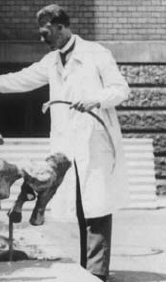
Friedrich von Huene, born Friedrich Richard von Hoinigen, was a German paleontologist who renamed more dinosaurs in the early 20th century than anyone else in Europe. He also made key contributions about various Permo-Carboniferous limbed vertebrates.

Plateosaurus is a genus of plateosaurid dinosaur that lived during the Late Triassic period, around 214 to 204 million years ago, in what is now Central and Northern Europe. Plateosaurus is a basal (early) sauropodomorph dinosaur, a so-called "prosauropod". The type species is Plateosaurus trossingensis; before 2019, that honor was given to Plateosaurus engelhardti, but it was ruled as undiagnostic by the ICZN. Currently, there are three valid species; in addition to P. trossingensis, P. longiceps and P. gracilis are also known. However, others have been assigned in the past, and there is no broad consensus on the species taxonomy of plateosaurid dinosaurs. Similarly, there are a plethora of synonyms at the genus level.

Procompsognathus is an extinct genus of coelophysid theropod dinosaur that lived approximately 210 million years ago during the later part of the Triassic Period, in what is now Germany. Procompsognathus was a small-sized, lightly built, ground-dwelling, bipedal carnivore, that could grow up to 1 m (3.3 ft) long.

Liliensternus is an extinct genus of basal neotheropod dinosaur that lived approximately 210 million years ago during the latter part of the Triassic Period in what is now Germany. Liliensternus was a moderate-sized, bipedal, ground-dwelling carnivore, that could grow up to 5.15 m (16.9 ft) long. It is the best represented Triassic theropod from Europe and one of the largest known.
Velocipes is a saurischian dinosaur genus from the Late Triassic that may have been a theropod; its fossils were found in the Norian-age Lissauer Breccia of southern Poland.
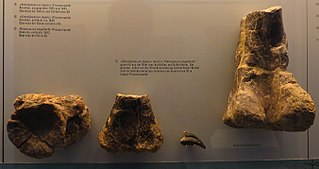
Gresslyosaurus is a genus of plateosaurian sauropodomorph dinosaur that lived during the Late Triassic period, around 214 to 204 million years ago, in France, Germany and Switzerland.
Pachysauriscus is a genus of plateosaurian sauropodomorpha from the Late Triassic (Norian) of southern Germany. Although previously synonymized with Plateosaurus, a number of papers published since the early 2000s have cast doubt on this synonymy.
Halticosaurus (pron.:"HAL-tick-oh-SORE-us") is a dubious genus of theropod dinosaur from the late Triassic period. It is known from a single fragmentary fossil specimen of the species H. longotarsus, found in the Middle Stubensandstein formation of what is present-day Germany The only known specimen was poorly preserved and may have been put together from bones of unrelated animals. Further research would be required to determine which of the bones belonged together, and what kind of theropod Halticosaurus was. However, most of the bones have been lost. For these reasons, Halticosaurus is considered to be a nomen dubium.

Teratosaurus is a genus of rauisuchians known from the Triassic Stubensandstein of Germany. It is estimated to be 6.2 meters (20.35 ft) long.
Zanclodon is an extinct genus of archosauriform from the Erfurt Formation in southern Germany. It was once a wastebasket taxon until a taxonomic revision by Schoch (2011) left only the paratype within Zanclodon laevis proper. The type species is Z. laevis.

Efraasia is a genus of basal sauropodomorph dinosaur. It was a herbivore which lived during the middle Norian stage of the Late Triassic, around 210 million years ago, in what is now Germany. It was named in 1973 after Eberhard Fraas, who during the early twentieth century collected what were the original type specimens.
Peter Malcolm Galton is a British vertebrate paleontologist who has to date written or co-written about 190 papers in scientific journals or chapters in paleontology textbooks, especially on ornithischian and prosauropod dinosaurs.
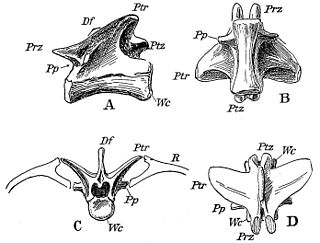
Pterospondylus is a dubious genus of theropod dinosaur from the Late Triassic. It was a coelophysid theropod which lived in what is now Germany. The type species, Pterospondylus trielbae,, was described by Jaekel in 1913-14 for a single back vertebra found inside the shell of the Proganochelys turtle. Sometimes, it is aligned with Procompsognathus, or even considered to be synonymous with it, despite being based on a vertebra that is twice the size of the corresponding bone in Procompsognathus. P. trielbae has no diagnostic features and is therefore considered a nomen dubium.

Plateosauridae is a family of plateosaurian sauropodomorphs from the Late Triassic of Europe, Greenland, Africa and Asia. Although several dinosaurs have been classified as plateosaurids over the years, the family Plateosauridae is now restricted to Plateosaurus, Yimenosaurus, Euskelosaurus, and Issi. In another study, Yates (2003) sunk Sellosaurus into Plateosaurus. Gresslyosaurus is alternatively considered its own genus or a synonym of Plateosaurus.

Otto Max Johannes Jaekel was a German paleontologist and geologist.
The Löwenstein Formation is a lithostratigraphic formation of the Keuper in Germany. It is underlain by the Mainhardt Formation and overlain by the Trossingen Formation. It dates back to the middle Norian.
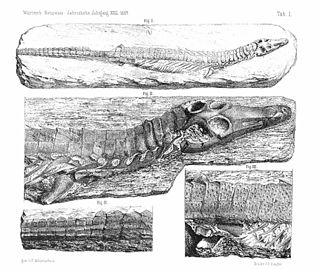
Dyoplax is an extinct genus of pseudosuchian archosaur, possibly an erpetosuchid. Fossils have been found from the type locality within the upper Schilfsandstein Formation in Stuttgart, Germany. The holotype specimen was a natural cast of a nearly complete skeleton that lacked only parts of the tail and limb bones.
The Stuttgart Formation is a geologic formation in Germany. It preserves fossils dating back to the Carnian stage of the Triassic period.
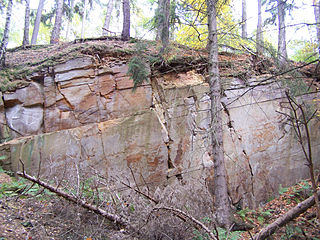
The Exter Formation is the only formation of the Upper Keuper or Rhätsandstein, and is a geologic formation in Germany. It preserves fossils dating back to the Rhaetian of the Triassic period.
The Klettgau Formation is a geological formation in Switzerland. It is Late Triassic in age, covering most of the mid to late Norian, the Carnian, and into the Rhaetian, spanning a period of 26-30 million years.

















